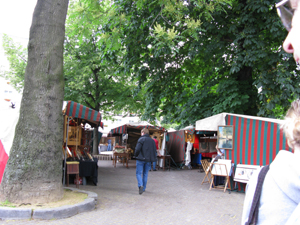 From the Beaux Arts Museum
From the Beaux Arts Museum
 From the Beaux Arts Museum
From the Beaux Arts Museum
The Atlas Hotel provided basic services. We had the largest room, and in fact many of the Belgian hotels in our price range do not offer a room for three people. We had room for three beds, with two armchairs stuffed in corners, and a small desk with chair. Television broadcasts came in French, Flemish, and CNN. The hardest exercise was watching a cartoon or sit-com in which the actors spoke English and the subtitles were in Flemish, but the ads were in French. With our one laptop, we worked out a routine for sharing. The hotel offered one internet computer, in the basement breakfast room. It was generally tied up in the afternoon and early evening. Eventually we learned from a fellow guest that if we brought our laptop downstairs, we could catch the
 The weekend Antiques market
wireless signal, and finally, following some apparent repairs to the hotel server, we were able to reach the Internet in our room as well. Google, having figured out where we were, tried its best to get us to use its French-language pages. But since we spent most of our waking hours outdoors, we didn't worry.
The weekend Antiques market
wireless signal, and finally, following some apparent repairs to the hotel server, we were able to reach the Internet in our room as well. Google, having figured out where we were, tried its best to get us to use its French-language pages. But since we spent most of our waking hours outdoors, we didn't worry.
We remembered the antiques market which is held each weekend in the Parc du Sablon in Brussels, so on Saturday morning, bright and early, we headed out on foot and reached the market just as it was setting up. Seeing the china, tableware, postcards, jewelry, paintings, picture frames, rugs, gloves, pipes, porcelain objects and whatnots, we are reminded that this market has operated  The Beaux Arts Museum
every week for decades, perhaps a hundred or more years -- where DO they get all the stuff?
The Beaux Arts Museum
every week for decades, perhaps a hundred or more years -- where DO they get all the stuff?
We moved on to Brussels' fine art museum, the Beaux Arts museum. As we waited for the opening, we noticed a number of young men and women in green t-shirts, armed with cameras. They were competing in a photo contest, taking pictures of the life of the city. Bob and Elsa were happy to pose for one young photographer, who promptly emailed us his work -- we are just tickled with the result, "The Jolly Tourists" -- (our title).
 The Jolly Tourists
The museum occupied us happily for the greater part of the day. It is really two major museums: the Museum of Ancient Art, established in 1801, and the Museum of Modern Art, started in 1984. They are connected by a passageway and will be
enhanced in a year or so by the addition of the Museum of Rene Magritte, a Brussels native. We began our tour by looking at paintings by Rubens and other painters of the period. We found an intriguing special exhibit of the work of Josef Plecnik, a Slovenian architect and artist. The exhibit contains models of several of his buildings and one bridge (we later saw a different model of the same bridge in Mini-Europe). We found his work
The Jolly Tourists
The museum occupied us happily for the greater part of the day. It is really two major museums: the Museum of Ancient Art, established in 1801, and the Museum of Modern Art, started in 1984. They are connected by a passageway and will be
enhanced in a year or so by the addition of the Museum of Rene Magritte, a Brussels native. We began our tour by looking at paintings by Rubens and other painters of the period. We found an intriguing special exhibit of the work of Josef Plecnik, a Slovenian architect and artist. The exhibit contains models of several of his buildings and one bridge (we later saw a different model of the same bridge in Mini-Europe). We found his work
 Rubens cupids
particularly appealing because of his Art Nouveau elements and his particular care in selecting the woods used in furniture and buildings. He is considered one of the most influential Slovenian artists, and had a considerable effect on the capital, Ljubljana. Also, judging from the quotations from his diaries posted throughout the exhibit, he was a kindly and philosophic man.
Rubens cupids
particularly appealing because of his Art Nouveau elements and his particular care in selecting the woods used in furniture and buildings. He is considered one of the most influential Slovenian artists, and had a considerable effect on the capital, Ljubljana. Also, judging from the quotations from his diaries posted throughout the exhibit, he was a kindly and philosophic man.
After lunch in the museum cafe we moved on to 19th century paintings and sculpture. We were disappointed to find that the museum is not exhibiting the Magritte paintings we had remembered; they are saving them for their new quarters; however, there were enough exhibits to fill our afternoon.
Following the pattern we have now established, we walked and walked and walked and got home. Bob kept saying he was taking us "a different way." Fortunately, it was mostly downhill.